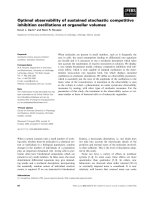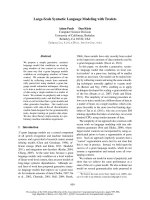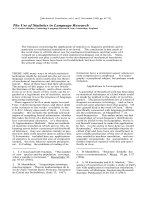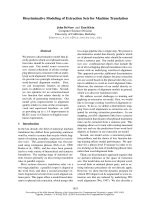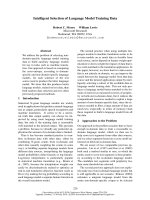Báo cáo khoa học: "STOCHASTIC MODELING OF LANGUAGE VIA SENTENCE SPACE PARTITIONING" potx
Bạn đang xem bản rút gọn của tài liệu. Xem và tải ngay bản đầy đủ của tài liệu tại đây (297.52 KB, 3 trang )
STOCHASTIC MODELING OF LANGUAGE VIA SENTENCE SPACE PARTITIONING
Alex Martelli
IBM Rome Scientific Center
via Giorgione 159, ROME (Italy)
ABSTRACT
In some computer applications of linguistics (such as
maximum-likelihood decoding of speech or handwriting), the
purpose of the language-handling component (Language
Model) is to estimate the linguistic (a priori) probability of
arbitrary natural-language sentences. This paper discusses
theoretical and practical issues regarding an approach to
building such a language model based on any equivalence
criterion defined on incomplete sentences, and experimental
results and measurements performed on such a model of the
Italian language, which is a part of the prototype for the
recognition of spoken Italian built at the IBM Rome
Scintific Center.
STOCHASTIC MODELS OF LANGUAGE
In some computer applications, it is necessary to have a
way to estimate the probability of any arbitrary
natural-language sentence. A prominent example is
maximum-likelihood speech recognition (as discussed in [1],
[4], [7]), whose underlying mathematical approach can be
generalized to recognition of natural language "encoded" in
any medium (e.g. handwriting). The subsystem which
estimates this probability can be called a stochastic model of
the target language.
If the sentence is to be recognized while it is being
produced (as necessary for a real-time application), the
computation of its probability should proceed
"left-to-right," i.e. word by word from the beginning
towards the end of the sentence, allowing application of fast
tree-search algorithms such as stack decoding[5]
Left-to-right computation of the probability of any word
string is made possible by a formal manipulation based on
the definition of condit__ional probability: if W i is the i-th
word in the sequence 14' of length N, then:
N
e(W)= 1 IP(EI w,t , ~_~ ~'t)
i=1
In other terms, the probability of a sequence of words is the
product of the conditional probability of each word, given
all of the previous ones. As a formal step, this holds for full
sentences as well as for any subsequence within a sentence,
and also for multi-sentence pieces of text, as long as
sentence boundaries are explicitly accounted for (typically by
introducing a pseudo-word as sentence boundary marker).
We shall apply this equation only to subsequences occurring
at the start of sentences (i.e. "incomplete" sentences); thus,
the unconditional probability P(WI) can meaningfully be
read as the probability that the particular word WI, rather
than any other word, will be the one starting a sentence.
The language model will thus consist essentially of a
way to compute the conditional probability of any (target)
word given all of the words that precede it in the sentence.
For brevity, we shall call this (possibly empty) subsequence
of the sentence to the left of the target word its prefix, using
this term intcrchangeably with incomplete sentence, and we
shall refer to the operation of conditional probability
estimation given an incomplete sentence as predicang the
next word in the sentence. A stochastic language model in
this form may be said to be in predictive normal form [2].
The predictive power of two language models in
predictive normal form can always be compared on an
empirical basis, no matter how different their internal
structures may be, by using the perplexity statistic
introduced in [6]; the perplexity, computed by applying a
language model in predictive normal form to an arbitrary
body of text, can be interpreted as the average number of
words among which the model is "in doubt" at every
context along the text (this can be made rigorous along the
lines of the argument in [13]).
TRAINING THE MODEL
A naive statistical approach to the estimation of the
conditional probabilities of words given prefixes, to build a
language model in predictive normal form, would simply
collect occurrences of each prefix in a large corpus, using
the relative frequencies of following words as estimates of
probability. 'l'i~is is clearly unfeasible: no matter how large
the available corpus, the possible prefixes will be yet more
numerous; thus, most of them will not be observed in the
corpus, and those which are observed will only be seen
followed by a very limited and unrepresentative subset of
the words that can come after them.
This problem stems directly from the fact that the
number of elements in the set ("space") of different possible
(incomplete) sentences is too high; thus, it can be met
head-on by simply reducing the number of incomplete
sentences which are deemed to differ significantly for
predictinn purposes, i.e. by passing to the quotient space of
the sentence space on a suitable equivalence relation; in
other words, by using as, contexts of the language model,
the equivalence classes in a partition of the set of all
prefixes, rather than the prefixes themselves. The
equivalence classification of prefixes can be based on any
kind of linguistical knowledge, as long as it can be applied to
two prefixes to judge if they can be deemed "similar
enough" to allow us to expect that they should lead to the
same prediction regarding the next word to Le expected in
the sentence. Indeed, the knowledge embodied in the
equivalence classification need not be of the kind that would
be commonly labeled "[inguistical"; the equivalence criterion
91
between two sentence prefixes need not be any more than
the purely pragmatical "they behave similarly in predicting
the next following word."
Let us assume that we already had a stochastic language
model, in predictive normal form, somehow trained to our
satisfaction. To each string of words, considered as a
sentence prefix, there would be attached a probability
distribution over all words in the dictionary, corresponding
to the conditional probability that the word should follow
this prefix. We could now apply sentence-space partitioning
as follows: define a distance measure between probability
distributions over the dictionary; apply any clustering
algorithm to obtain the desired number of classes (or,
cluster iteratively until further clustering would require
merging of equivalence classes which are at a distance above
some threshold). By this hypothetical process, we would be
extracting linguistical knowledge (namely, which sequences
of words can be deemed equivalent as regards the word
which can be expected to follow them) from the model itself
(thus, presumably, from the data it was trained upon).
Since we don't have such a well-trained model to begin with,
we will actually have to reverse the process:
start
by
injecting some knowledge in the form of equivalence
criteria,
obtain
from this a way to practically train the
model.
One way to obtain the initial sentence-space partition
could be from a parser able to work left-to-right on natural
language sentences; each class in the partition would be the
set of all sentence prefixes that take the parser's state to a
given string of non-terminals (or rather, given the possibility
of ambiguous parses, to a given
set
of such strings). We
have not attempted this. What we
have
attempted is
obtaining the equivalence relation on string of words from
an equivalence relation on single words, which is far simpler
to define (although, being a further approximation, it can be
expected to give poorer results). Thus, if we define the
equivalences:
Michele ~ Giuseppe
pensa dlce
we will have that "Michele dice" is equivalent to "Giuseppe
pensa," and so on. One big advantage is that such
equivalence classes on single words are relatively easy to
obtain automatically (by clustering over any appropriate
distance measure, as outlined in the hypothetical example
above - the difference being that we can train single words
adequately, without having to resort to a previous
classification), thus leading to an automatical (although far
from optimal) sentence-space partitioning on which the
model's training can be based.
It should be noted at this point that this approach
suffers from the "synonym problem": since equivalence
relationships enjoy the transitive property, we risk deeming
"equivalent" two items A and B which are actually quite
different, by virtue of the fact that they both "resemble" a
third item C. This problem depends on the "all or nothing"
nature of equivalence relationships, and could be bypassed
by a mathematically more general approach, based on the
theory of Marker Sources (as outlined in ['3], [g]). The
latter can be said to stern from a generalization of
sentence-space partitions to "fuzzy partitions" (probabilistic
covers), i.e. frnm usage of a nondeterministic equivalence
relation. I lowever, as argued in rlO], the greater generality,
although aesthetically appealing, and no doubt useful against
the "synonym problem," does not necessarily add enough
power to the language model to offset the added
computational burden; in many cases, Markov-source
models can be practically reduced to sentence-space
partitioning models.
One further generalization is the identification of
equivalence relationships between word strings of different
length. For example, verb forms such as "dice" or "pensa"
could be deemed equivalent to themselves prefixed by the
word "non," finally leading to equivalence between, say,
"Marie dice" and "Giuseppe non pensa." Such equivalences
could also, in principle, be tested automatically on statistical
grounds. Finally, equivalence criteria thus obtained via
statistical means are by no means ends in themselves, but
can be integrated with other linguistical knowledge
expressed as a partition of the sentence space, to build a
stronger model. Indeed, the set of language models built on
sentence space partitions inherits mathematical lattice
properties from the set of partitions itself, through their
natural correspondence, allowing simple but useful
operation on language models to yield new language models.
For example, the "least upper bound" operation on two
language models gives the model based on the equivalence
criterion which requires
both
equivalence criteria from the
original models to be satisfied. Thus, for example, we could
start from an equivalence criterion O defined on purely
grammatical grounds (for example, by using a parser, such
as suggested above), and another equivalence criterion S
defined on statistical grounds (such as we have built as
outlined above), and
merge
them into a new criterion SO,
the laxer one which is still stronger than either, to obtain a
finer partition (and thus, presumably, a better performing
stochastical language model, assuming a reasonably large
corpus is available to train it on).
APPLICATION AND RESULTS
Given a suitable equivalence criterion over prefixes, and
a large corpus, the language model can now in principle be
built by purely statistical means, by collecting the multiset of
words following each equivalence class (context), and using
relative frequencies as estimators of conditional
probabilities. However, this would require that the
equivalence criterion be so lax (i.e., that it have so few
contexts) that each of its contexts can be
guaranteed
to
occur in the corpus
followed
by
all
different words that can
possibly follow it, despite possible statisUcal fluctuations.
This is an overly severe restriction that, even for a quite
large corpus, would in practice constrain the model builder
to use very weak equivalence classifications (i.e. ones of little
discriminatory power).
A generalization of the
backing-off
methodology first
proposed in [q] can be used to overcome this limitation.
Rather than a single sentence-space partition, the model will
need a
chain of
such partitions, progressively weaker, and
ending with the weakest possible "partition" - the one which
considers any prefix equivalent to any other (the maximal
element in lhe above-mentioned lattice). "Elementary"
92
models will be built, with the above statistical procedure,
over each partition of the chain.
When using the model (now built as a chain of
elementary models) in predictive form, if a prediction cannot
be reliably obtained from the strongest model in the chain,
the algorithm will then bacl~-off to the next weakest model,
and proceed recursively along the chain of elementary
models until it finds one that can give a reliable prediction
(the existence in the chain of the weakest conceivable model
ensures termination).
The method requires that, along with its predictions, an
elementary model deliver, for any given context, a measure
of its own reliability. This can be quantified as follows: in
any context, an elementary model must estimate the
probability that the next word will not be in the set actually
observed for that model in that context (i.e., the set of
words it is able to predict). Thus, each step of backing-off
will be performed in two cases: unconditionally, if an
elementary model has no observations at all for prefixes
equivalent to the target one; conditionally, if that context
was indeed observed, but the target word was not observed
in it (and in this latter case, the self-estimate of reliability of
the elementary model will come into play).
For the estimation of the global probability of
unobserved words in a context ("new" observations), there
could be used the general approaches, based on Turing's
heuristic, discussed in [ I 1 ] and [ 12], which lead, in practice,
to estimating the probability of "new" observations as the
ratio of words observed once to total observations. We
have found it more reliable to use a simpler approach (the
.
"First-Time" heuristic), which directly estimates the
probability of new observations as the ratio of different
words observed to total observations.
This idea leads to strictly more pessimistic estimates of
reliability of elementary models (in particular, it treats any
word observed only once in a context as if never observed
at all) and, judging from experimental results, seems to
better model actual linguistic behavior. As expected, it
proves particularly valuable when judging predictive power
over poorly-trained material, specifically Italian sentences in
a domain of discourse different from that of the training
corpus. Using training data from the "II Mondo" weekly
magazine, the perplexity (with an 8000-word vocabulary)
over other test sentences from the same magazine came to
113, and over news flashes from the Ansa agency to 174,
using Turing's heuristic; while using the First-Time heuristic
under the same experimental conditions gave values of II I
and 150 respectively.
Particularly with this heuristic, cross-domain behavior
of such models appears quite acceptable. Our main training
corpus was a set of articles and news flashes on economy
and finance, from the "II Mondo" weekly magazine and the
"Ansa" new agency, for a total of about 6 million words;
addition of just 50,000 words of inter-office memoranda
made the perplexity of another test set of such memoranda
(on a 3000-word vocabulary) decrease from 149 to 115,
while naturally perplexity on test material homogeneous to
the main body of the training corpus remained fixed (at 76).
REFERENCES
[l]
I R. Bahl, F. Jelinek, R.L Mercer, A
maximum
likelihood approach to eontinuous speech
recognition, IEEE Trans. PAMI, March 1983.
[2]
R. Campo, L. Fissore, A. Martelli, G. Micca, G.
Volpi, Prohahilistie Models
of the
Italian
Language for Speech Recognition, Proc. Int.
Work. Authomatic Speech Recognition, Roma,
Ilaly, May 1986.
[3]
A.M. Derouault, B. Merialdo, Language
modeling at
the syntactic
level, Proc. Seventh Int.
Con]: Pattern Recognition, Montreal, Canada,
July 30-August 2, 1984.
1-4.1
Is]
P. D'Orta, M. Ferretti, A. Martelli, S.
Melecrinis, S. Scarci, G. Volpi, II prototipo IBM
per il riconoscimento del parlato, Note di
Informatica, n. 13, September 1986.
F. Jelinek, A fast sequential decoding
algorithm
using a Mack, IBM Journal of Research and
Development, November 1969.
[63
F lelinek, R.L. Mercer, L.R. Bahl, J.K. Baker,
Perplexity - a
measure of difficulty of
speech
recognition tasks, 94th Meeting Acoustical Society
of America, Miami Beach, FL, December 15,
1977.
[7]
F. Jelinek, The
development of
an experimental
discrete dictation recognizer, Proceedings of
IEEE, November 1985.
[81
F. Jelinek, Self-Organized Language Modeling
for
Speech Recognition, IBM internal memo,
February 1986.
I-9]
S. Katz, Recursive M-gram Language Model via
a
Smoothing of
Turing's Formula, IBM Technical
Disclo.~tre Bulletin, 1985.
ElO]
A. Martelli, Modelli probabilistici della lingua
italiana, Note dl Informatica, n. 13, September
19~6.
Ell3
[123
A. Nadas, Estimation of probabilities in
the
language
model of the
IBM speech recognition
system, IEEE Trans. on Acoustic, Speech and
Signal Processing, August 1984.
A. Nadas, On Turing's Formula for Word
Prolmhilities, IEEE Trans. on Acoustic, Speech
and Signal Processing, December 1985.
['13] C.E. Shannon, Prediction and entropy
of printed
F.nglish, I~ell. S),st. Tech. Journal, 1951.
93

